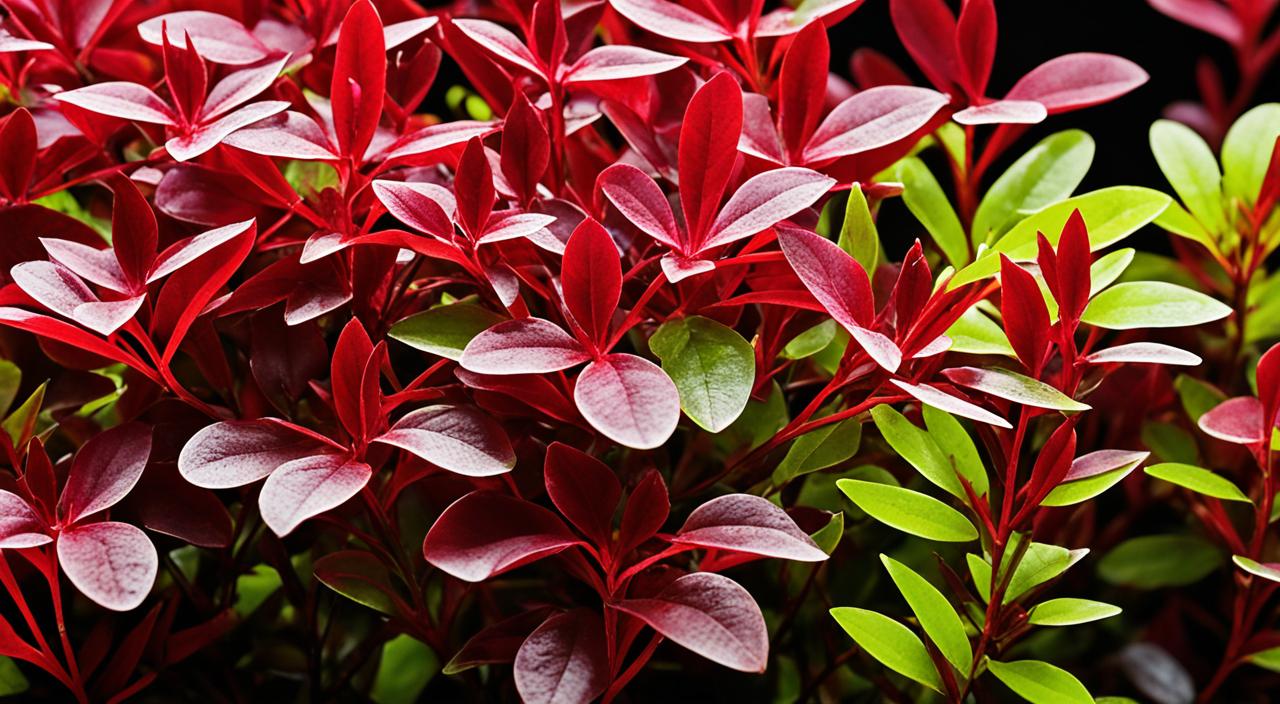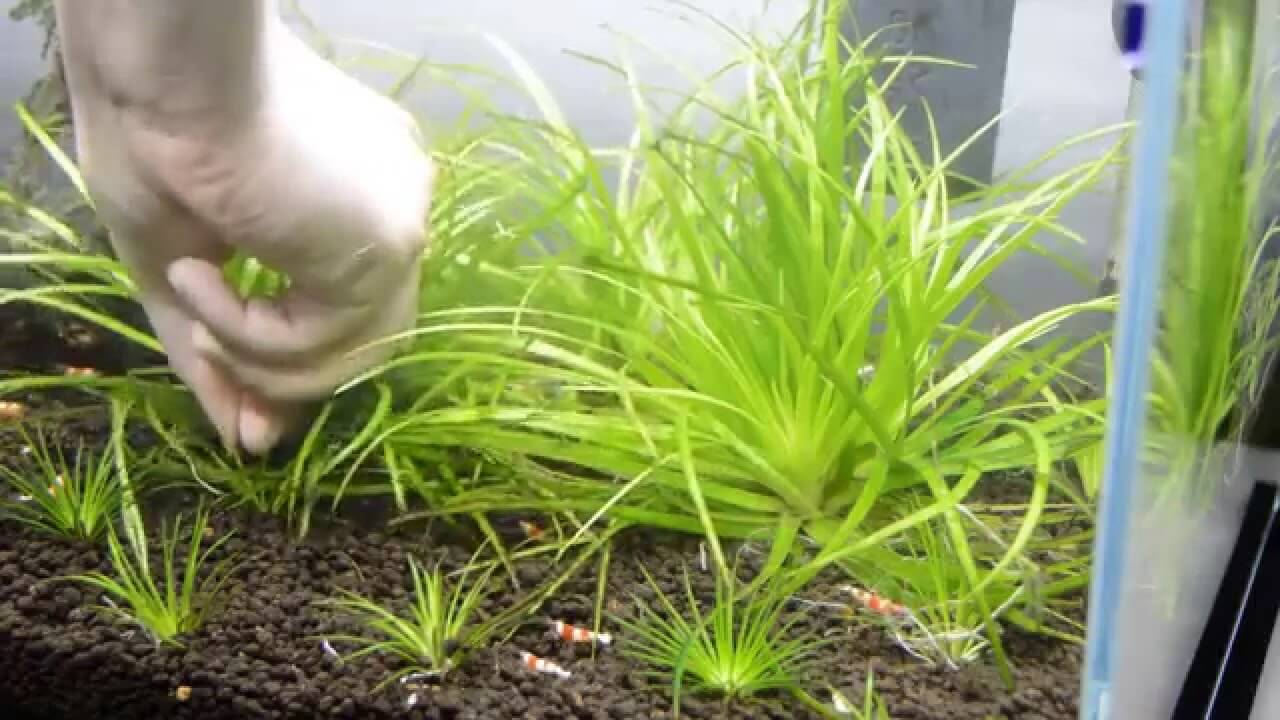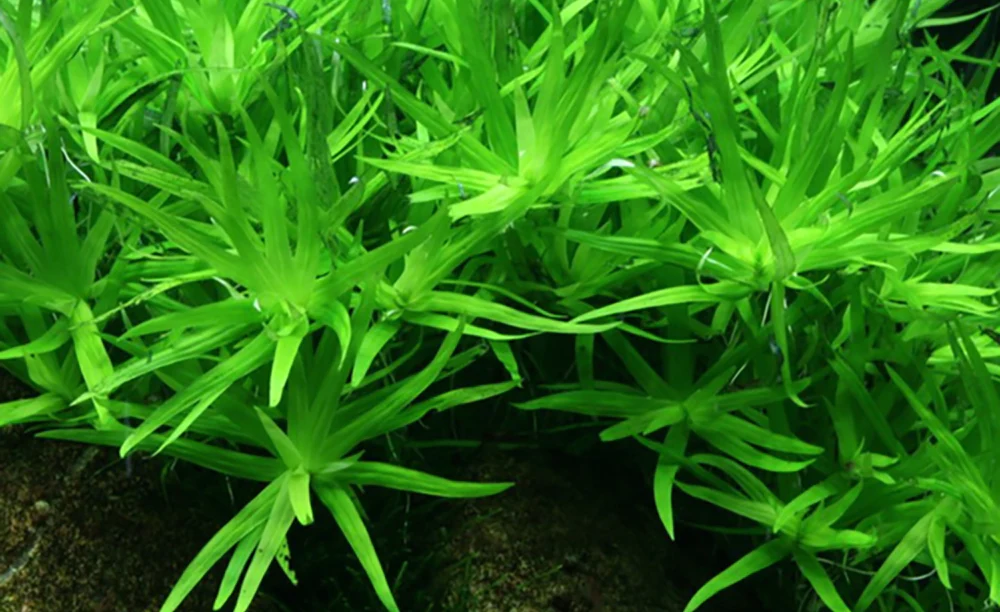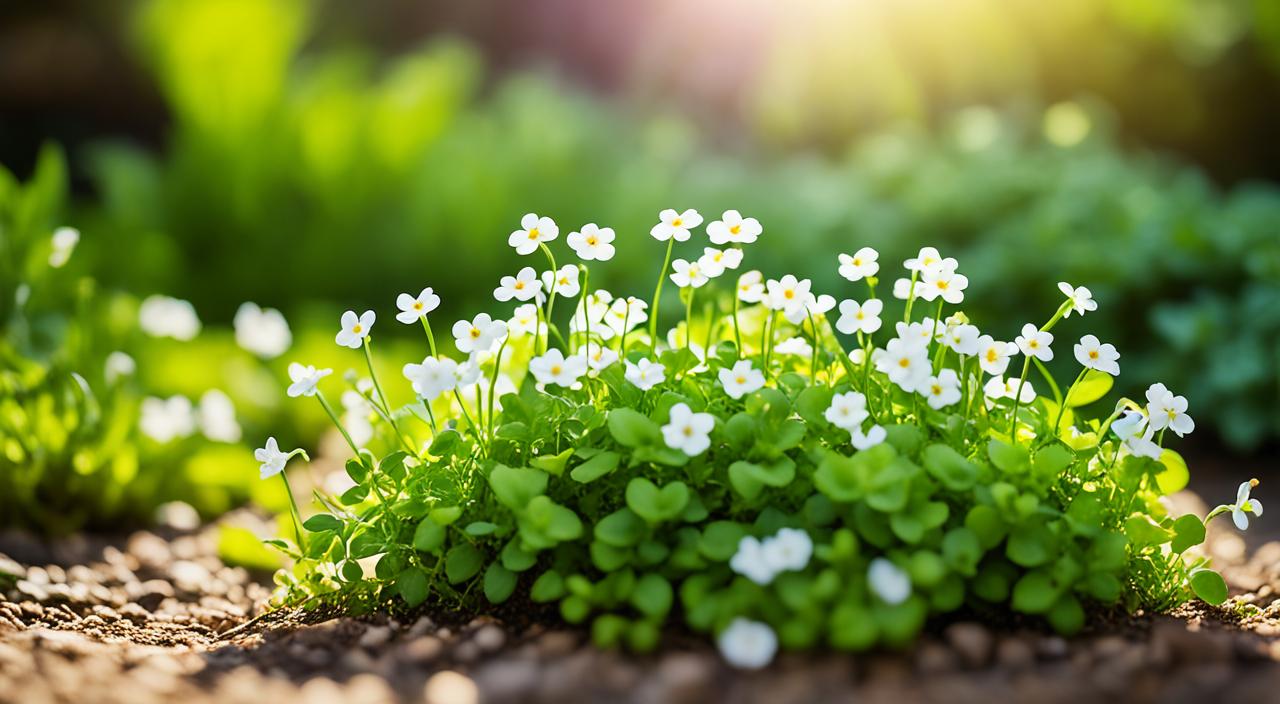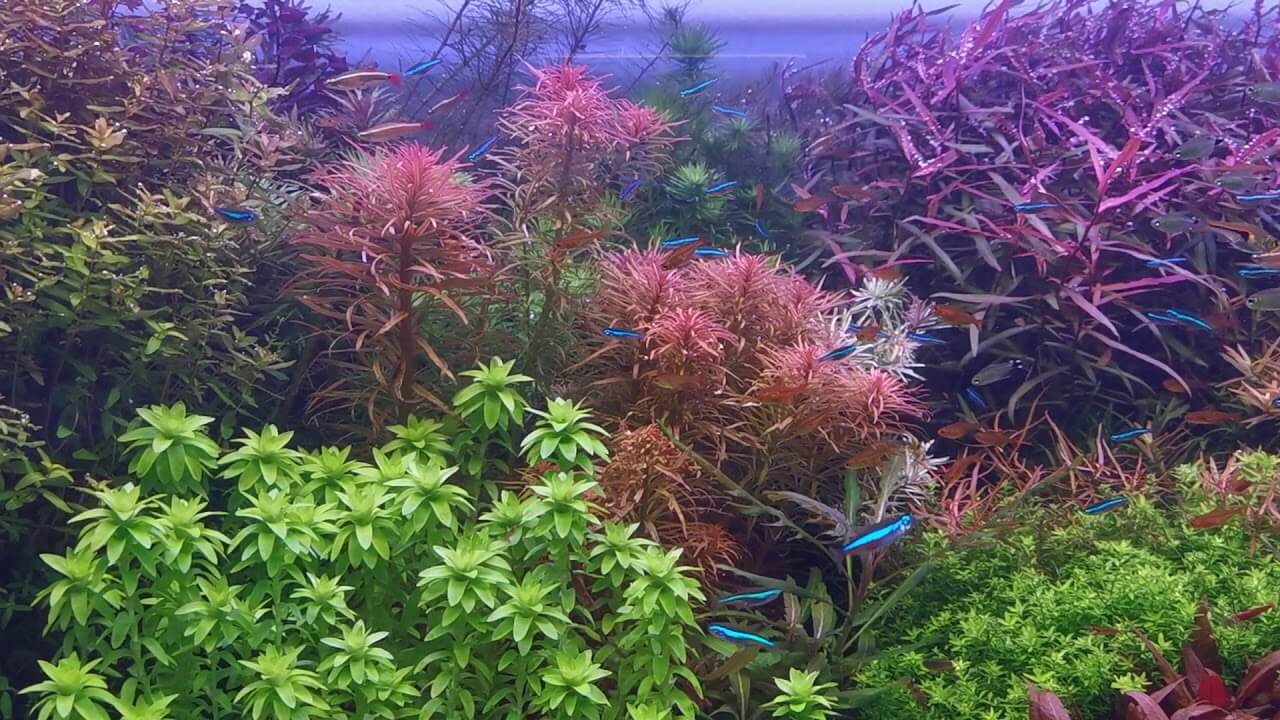Greetings, fellow aquarists! Today, I want to introduce you to a captivating plant that will add a vibrant splash of colour to your aquarium – Ludwigia Rubins. With its striking dark red leaves and stalks, Ludwigia Rubins is a variety of Ludwigia repens that will transform your tank into a visual masterpiece.
Ludwigia Rubins is a popular choice among aquascaping enthusiasts who want to create a captivating aquatic environment. Not only does it provide a stunning contrast to the green shades of other plants, but it also adds depth and visual interest to your tank.
This article will serve as your comprehensive guide to caring for Ludwigia Rubins and creating a thriving aquatic habitat. Join me as we delve into these beautiful red aquarium plants’ origins, morphological characteristics, placement, lighting, tank mates, feeding, CO2 injection, care, maintenance, and health.
Key Takeaways:
- Ludwigia Rubins is a variety of Ludwigia repens known for its striking dark red leaves and stalks.
- This vibrant plant adds colour and visual interest to your aquarium.
- It thrives under high-intensity lighting and requires nutrient supplementation for optimal growth.
- Compatible tank mates include peaceful community fish species.
- Regular care, maintenance, and monitoring are essential for the plant’s health and vitality.
Brief Overview Of Ludwigia Rubins
Ludwigia Rubins is a type of aquatic plant in the Ludwigia genus. It is characterized by its vibrant dark red leaves and stalks, adding a lush red colour to your aquarium. This plant creates a striking visual display that can become the focal point of your tank. Ludwigia Rubins is native to North America and is commonly found in freshwater habitats. As a fast-growing plant, it can quickly fill up space in your aquarium, creating a vibrant and captivating underwater landscape.
Ludwigia Rubin Information Table:
| Attribute | Description |
|---|---|
| Scientific Name: | Ludwigia repens ‘Rubin’ |
| Common Names: | Ludwigia Rubin, Red Ludwigia |
| Origin: | Hybrid/Cultivar, originally based on species from the Americas |
| Height: | Up to 20 inches (50 cm) |
| Growth Rate: | Medium to Fast |
| Colour: | Deep red to burgundy leaves |
| Aquarium Placement: | Midground to Background |
| Water Type: | Freshwater |
| pH: | 5.0 – 7.5 |
| Care Level: | Moderate |
| Light Requirements: | Recommended for best growth and colour development |
| CO2 Requirements: | Hybrid/Cultivar, based initially on species from the Americas |
| Temperature: | 64°F – 82°F (18°C – 28°C) |
| Flow Rate: | Moderate to High – Prefers some movement in the water for nutrient uptake |
| Propagation: | Cut stem and replant |
| Feed Type: | Benefits from liquid fertilizers and CO2 supplementation |
With the proper care and conditions, Ludwigia Rubins can thrive and become a beautiful addition to any freshwater tank. Its lush red colour and unique aesthetic make it popular among aquascaping enthusiasts. Whether you’re a beginner or an experienced aquarist, Ludwigia Rubins can bring life and vibrancy to your aquarium, transforming it into a visually stunning underwater ecosystem.
Origins And Habitat
Ludwigia Rubins is a variety of Ludwigia repens native to North America. It can be found in Florida, Louisiana, and Texas. In its natural habitat, Ludwigia Rubins grows in shallow waters, marshes, and along the edges of ponds and streams. It prefers well-lit areas with intense sunlight. The plant can tolerate various water conditions, including acidic and slightly alkaline pH. It is often found in areas with relatively nutrient-rich soils. Ludwigia Rubins can be cultivated successfully in aquariums with the proper lighting, water parameters, and nutrient supplementation.
Morphological Characteristics
Ludwigia Rubins is known for its unique morphological characteristics. The plant displays stunning dark red leaves and stalks, creating an eye-catching burst of colour in your aquarium. The leaves of Ludwigia Rubins are relatively broad, measuring approximately 1 1/2 to 2 1/4 inches in width. The plant’s stems can reach a height between 7 3/4 to 20 inches, making it a tall and bushy addition to your aquatic environment. With its vertical growth, Ludwigia Rubins can efficiently fill up the space in your tank. This red aquatic plant can also produce lateral shoots, which can be cut and replanted to propagate new Ludwigia Rubins plants.
Placement And Lighting
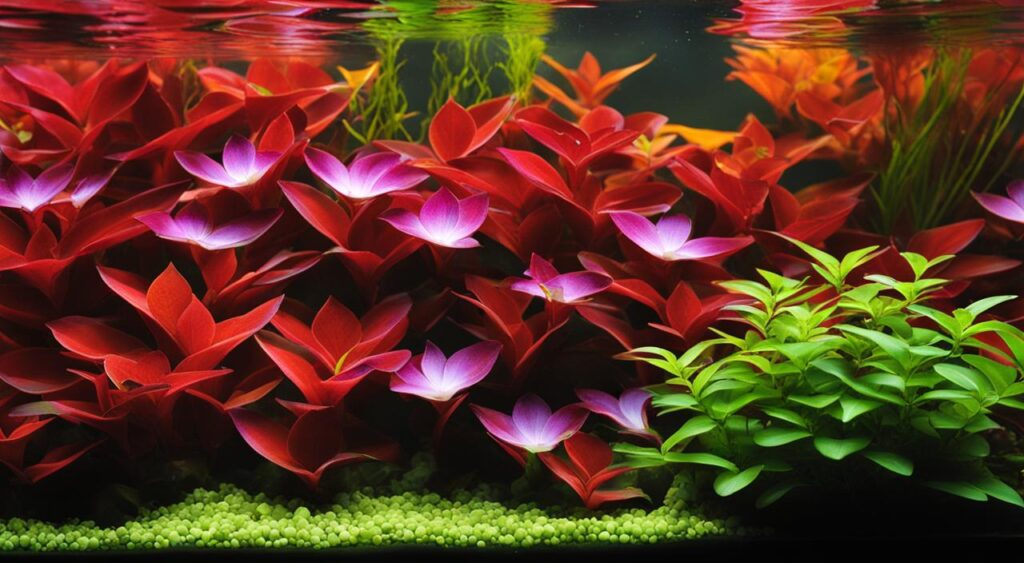
Regarding placement, Ludwigia Rubins is best suited for the mid to background of your aquarium. The plant can grow relatively tall, ideal for filling up vertical space. Ludwigia Rubins requires high-intensity lighting to maintain its vibrant red colour. It thrives under bright, direct lighting conditions with at least 3 watts per gallon of light. LED lights are famous for providing the necessary intensity to enhance Ludwigia Rubins’s red colour. Be sure to position the plant where it will receive adequate lighting to ensure its optimal growth and colouration.
What Are Good Tank Mates?
Good Tank Mates
Ludwigia Rubins is a peaceful plant that can coexist well with various fish species in your aquarium. When choosing tank mates, it is essential to consider peaceful community fish that won’t disturb or damage the plant. Some suitable tank mates for Ludwigia Rubins include guppies, tetras, rasboras, and corydoras catfish. These fish are known for compatibility with live plants and are unlikely to harm the Ludwigia Rubins.
Introducing these fish species to your tank can create a harmonious and visually appealing aquatic environment. Their peaceful nature and smaller size make them less likely to disturb or uproot the plant. Additionally, these fish provide an excellent contrast to the vibrant red colour of the Ludwigia Rubins, enhancing the overall aesthetic appeal of your aquarium.
Fish Species To Avoid
While many fish species can peacefully coexist with Ludwigia Rubins, avoiding certain types of fish that may threaten the plant is crucial. These fish species are either known to be plant-eaters or have aggressive tendencies, which could result in damage to or consumption of the Ludwigia Rubins.
Examples of fish species to avoid include goldfish, cichlids, and certain types of barbs. Goldfish are notorious for their plant-consuming behaviour, and their larger size can also threaten delicate plants like Ludwigia Rubins. Cichlids, particularly those known for their territorial and aggressive nature, can uproot or damage plants during territorial disputes.
It is vital to research the compatibility of fish species with live plants before introducing them to your aquarium. By choosing suitable tank mates and avoiding plant-eaters or aggressive species, you can create a thriving ecosystem where Ludwigia Rubins can flourish and serve as a focal point of your aquarium.
Feeding (Fertilization)
Ludwigia Rubins is a nutrient-demanding plant that benefits from regular feeding and fertilization. This plant requires additional nutrients to thrive and maintain its vibrant red colour.
You can feed Ludwigia Rubins with liquid fertilizers formulated explicitly for aquatic plants. Follow the instructions on the fertilizer packaging for the appropriate dosage and frequency of application.
It is important to note that overfeeding can lead to algae growth and water quality issues. Start with a small amount of fertilizer and gradually increase the dosage if necessary. Monitor the plant’s growth and adjust the feeding regimen accordingly.
How Much and How Often to Feed
When feeding Ludwigia Rubins, it’s essential to strike a balance. The goal is to provide enough nutrients for the plant’s growth and colouration without causing nutrient imbalances or algae outbreaks.
Start by following the recommended dosage provided by the fertilizer manufacturer. Typically, it is advised to start with 1-2 pumps per 10 gallons of water every two weeks. Monitor the plant’s response and adjust the dosage accordingly. If you notice slower growth or paler colouration, slightly increase the dosage. On the other hand, if you observe excessive algae growth, reduce the amount of fertilizer.
It’s important to remember that Ludwigia Rubins is a fast-growing plant and can consume nutrients quickly. Regularly monitor the plant’s growth and adjust the feeding frequency as needed. If the plant exhibits healthy growth and vibrant colouration, maintain the feeding regimen. However, if the plant shows signs of nutrient deficiencies or slower growth, consider increasing the feeding frequency to once a week.
A balance between regular feeding and close observation of the plant’s response will help ensure optimal growth and colouration of Ludwigia Rubins in your aquarium.
CO2 Injection
Ludwigia Rubins, like many other aquatic plants, can significantly benefit from carbon dioxide (CO2) supplementation in the aquarium. CO2 injection provides a valuable source of carbon, which is essential for photosynthesis and the healthy growth of the plant. By ensuring an adequate supply of CO2, you can promote lush foliage and vibrant colouration in Ludwigia Rubins.
Types
There are several methods of CO2 injection that you can consider for your aquarium:
- CO2 canisters: CO2 canisters are a popular option for injecting carbon dioxide into the aquarium water. They typically contain pressurized CO2 gas that can be released into the aquarium through a regulator and diffuser system.
- CO2 gas diffusers: Gas diffusers allow for the controlled release of CO2 gas into the aquarium water. They disperse the carbon dioxide in the form of tiny bubbles, which the plants then absorb.
- Liquid carbon supplements: Another option is liquid carbon supplements formulated explicitly for aquarium plants. These supplements contain carbon compounds that plants can readily use for photosynthesis.
When implementing CO2 injection, it is crucial to do so in moderation. Excessive levels of CO2 can be harmful to fish and other aquatic organisms. It is best to start with a low dosage and monitor the plant’s response before adjusting. Consulting with a knowledgeable aquarist or aquarium specialist can provide valuable guidance on CO2 injection for Ludwigia Rubins and other aquarium plants.
Care
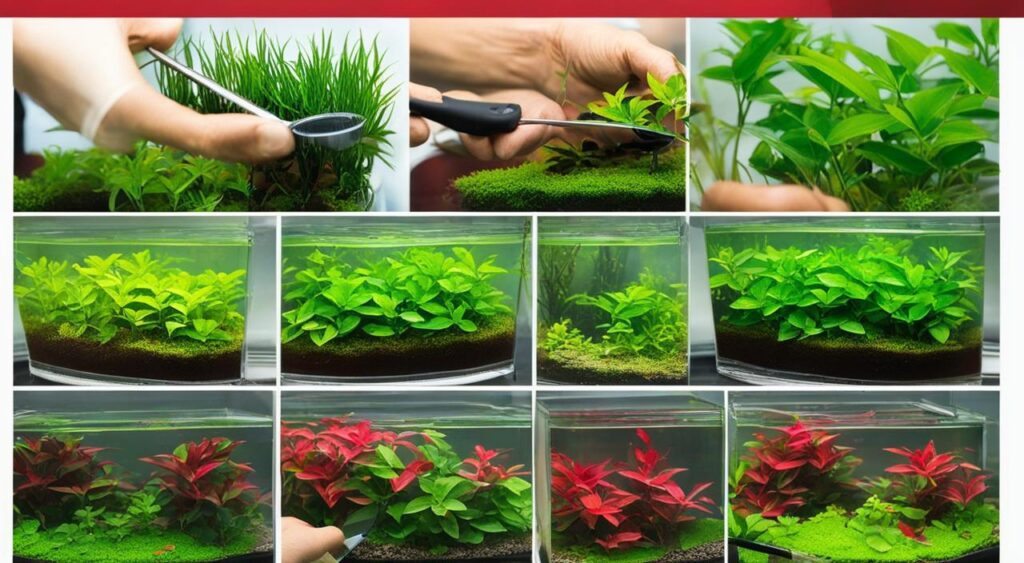
Proper care is essential for the successful cultivation of Ludwigia Rubins. To ensure optimal growth and colouration, it is crucial to maintain the proper tank parameters, water quality, filtration, and flow.
Planted Tank Parameters
Ludwigia Rubins thrives in a planted tank with a substrate that provides essential nutrients for the plant’s roots. Choose a substrate that is rich in nutrients and has a sound drainage system. This will allow the plant’s roots to access the necessary minerals and promote healthy growth.
Water Quality
Maintaining good water quality is crucial for Ludwigia Rubins’s health. The water should be kept slightly acidic to neutral, with a pH level ideally between 6.0 to 7.0. Regularly test the water parameters and make necessary adjustments to ensure a stable and suitable environment for the plant.
Filtration
Installing a reliable filtration system is essential to keep the water clean and debris-free. A sound filtration system will help remove waste, excess nutrients, and harmful substances, maintaining optimal water quality for Ludwigia Rubins. Choose a filter appropriate for your aquarium’s size and follow the manufacturer’s instructions for maintenance and cleaning.
Flow
A moderate to strong flow in the aquarium is beneficial for Ludwigia Rubins. It helps distribute nutrients and oxygen to the plant, promoting healthy growth. Consider adding a powerhead or adjusting the flow rate of your filter to ensure adequate water movement throughout the tank.
| Aspect | Parameters |
|---|---|
| Lighting | High-intensity lighting with at least 3 watts per gallon |
| Temperature | 74°F – 82°F (23°C – 28°C) |
| pH | 6.0 – 7.0 |
| Carbon Dioxide (CO2) | Supplementation recommended |
| Nutrient Fertilization | Regular feeding with liquid fertilizers formulated for aquatic plants |
| Water Flow | Moderate to strong flow |
Aquarium Maintenance
Proper aquarium maintenance is crucial for Ludwigia Rubins’s long-term health and vitality. Following a few key steps, you can ensure that your aquarium remains a thriving environment for your plants. This section will cover essential aspects of aquarium maintenance, including testing water conditions, setting up your aquarium tank, and propagation methods.
Testing Water Conditions
Regularly testing the water conditions in your aquarium is essential to ensure optimal growth and health for your Ludwigia Rubins. Test the pH, ammonia, nitrite, nitrate, and phosphate levels to ensure they are within the appropriate range. Monitoring these parameters allows you to make necessary adjustments to maintain a balanced and stable aquatic environment.
How To Set Up Your Aquarium Tank
When setting up your aquarium tank, remember a few key considerations. Start by providing a suitable substrate for essential plant root nutrients, such as aquarium gravel or aquatic soil. Additionally, establish a lighting system that meets the specific requirements of Ludwigia Rubins, ensuring it receives adequate light for optimal growth and vibrant red colouration.
Propagation Methods
Ludwigia Rubins can be propagated through stem cuttings, which allows you to create new plants and maintain their bushy growth. To propagate, carefully cut a healthy stem from the main plant and replant it in the aquarium substrate. Ensure the stem cutting has enough water and light to root and develop into a new Ludwigia Rubins plant. Regular pruning is also essential to prevent overcrowding and promote healthy growth.
Health And Disease
Monitoring Ludwigia Rubins’ health is essential to ensure its long-term viability. It is important to be aware of the signs of good health and be able to identify signs of poor health. Additionally, understanding common health issues and their treatments is crucial for maintaining the well-being of your Ludwigia Rubins plant. Lastly, being vigilant about plant pests and taking prompt action can prevent damage to the plant and maintain its overall health.
Signs Of Good Health
Signs of good health in Ludwigia Rubins include vibrant red colouration, indicating a healthy pigmentation process. The leaves should be lush and have a vibrant appearance. The plant should exhibit strong root development, which is essential for nutrient uptake and growth.
Signs Of Poor Health
Signs of poor health in Ludwigia Rubins may present as pale or discoloured leaves, indicating nutrient deficiencies or other underlying issues. Stunted growth and weak, decaying roots are also signs of poor health. Root rot, characterized by soft and discoloured roots, can further contribute to the plant’s overall health deterioration.
Common Health Issues And Treatment
Ludwigia Rubins may encounter common health issues, including nutrient deficiencies, algae overgrowth, and bacterial or fungal infections. Nutrient deficiencies can be addressed by appropriate fertilization and ensuring the plant receives a balanced diet of essential nutrients. Algae overgrowth can be controlled by maintaining optimal water parameters, providing adequate lighting, and implementing effective algae control measures. Bacterial or fungal infections may require specific treatments, such as targeted medications or adjustments to the tank environment.
Plant Pests
Ludwigia Rubins can be susceptible to plant pests such as snails and algae. Snails can damage the leaves and stems of the plant, hindering its growth and overall health. Algae can compete with Ludwigia Rubins for light and nutrients, leading to poor plant health and appearance. It is crucial to address these pests promptly to prevent further damage to the plant. Various methods, such as manual removal, introducing natural predators, or implementing appropriate algae control strategies, can be employed.
Summary
Looking to add vibrancy and visual interest to your aquarium? Ludwigia Rubins is the perfect choice. This stunning red aquatic plant can transform your underwater landscape into a captivating masterpiece. By following the proper care guidelines, you can ensure the optimal growth and colouration of Ludwigia Rubins, creating a vibrant and healthy environment for your aquatic companions.
Providing adequate lighting is crucial for the success of Ludwigia Rubins. High-intensity lighting with at least 3 watts per gallon will enhance the plant’s red colour and promote growth. Additionally, supplementing the plant with the proper nutrients through liquid fertilizers formulated for aquatic plants is essential to maintain its health and vibrancy.
Monitoring Ludwigia Rubins’ health is critical to its long-term viability. Look for signs of good health, such as vibrant red colouration, healthy leaf growth, and strong root development. Address any signs of poor health promptly to prevent issues from escalating. Ludwigia Rubins can encounter various health issues, from nutrient deficiencies to pests and diseases, so it’s important to stay vigilant and take appropriate action.
With the proper care and attention, Ludwigia Rubins can thrive and become the focal point of your aquarium. Its striking red leaves and stalks will bring life to your aquatic environment, creating a stunning underwater landscape that captivates you and your fish. Follow these care tips to ensure the vibrancy and longevity of Ludwigia Rubins, and enjoy the beauty it brings to your tank.
FAQ
What is Ludwigia Rubins?
Ludwigia Rubins is a variety of Ludwigia repens that is known for its striking dark red leaves and stalks. It is a popular red aquarium plant that adds vibrant colour to any freshwater tank.
How tall and wide does Ludwigia Rubins grow?
Ludwigia Rubins can grow up to 20 inches tall and 2 1/4 inches wide, making it a relatively tall and bushy plant that fills up vertical space in the aquarium.
Where is Ludwigia Rubins native to?
Ludwigia Rubins is native to North America and is commonly found in freshwater habitats such as shallow waters, marshes, and along the edges of ponds and streams.
What are the morphological characteristics of Ludwigia Rubins?
Ludwigia Rubins has dark red leaves and stalks, with broad leaves measuring around 1 1/2 to 2 1/4 inches in width. The stems of Ludwigia Rubins can grow to be between 7 3/4 to 20 inches tall.
Where should Ludwigia Rubins be placed in the aquarium?
Ludwigia Rubins is best suited for the mid to background of the aquarium due to its height. It requires high-intensity lighting to maintain its vibrant red colour.
What fish species can live with Ludwigia Rubins?
Good tank mates for Ludwigia Rubins include peaceful community fish such as guppies, tetras, rasboras, and corydoras catfish. It is important to avoid plant-eating or aggressive fish species.
How should Ludwigia Rubins be fertilized?
Ludwigia Rubins is a nutrient-demanding plant and benefits from regular feeding with liquid fertilizers specifically formulated for aquatic plants. Start with a small amount and adjust as needed.
Should carbon dioxide (CO2) be injected for Ludwigia Rubins?
Ludwigia Rubins can benefit from the supplementation of carbon dioxide (CO2) in the aquarium. CO2 injection provides a valuable source of carbon for photosynthesis and healthy growth.
What are the care requirements for Ludwigia Rubins?
Ludwigia Rubins thrives in a planted tank with a suitable substrate, slightly acidic to neutral pH levels, adequate filtration, and a moderate to strong flow. Regular monitoring and maintenance are important.
How should the aquarium be maintained for Ludwigia Rubins?
Regularly test water conditions, perform water changes, maintain stable parameters, provide suitable lighting, substrate, and follow propagation methods, while addressing any health issues or pests promptly.
What are the signs of good health for Ludwigia Rubins?
Signs of good health include vibrant red colouration, healthy leaf growth, and strong root development.
What are common health issues and pests for Ludwigia Rubins?
Common health issues include nutrient deficiencies, algae overgrowth, and bacterial or fungal infections. Pests such as snails and algae can also affect the plant.
How can Ludwigia Rubins enhance the visual appeal of an aquarium?
Ludwigia Rubins adds vibrant colour and visual interest to any freshwater aquarium, creating a beautiful and captivating underwater landscape.

